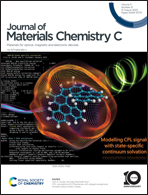Non-fused BODIPY-based acceptor molecules for organic photovoltaics†
Abstract
Thanks to the rise of efficient push–pull non-fullerene acceptors (NFAs), bulk-heterojunction organic solar cells have reached a high level of competitiveness with maximum power conversion efficiency over 18% for binary active layers. A common thread of most of these NFAs is the presence of a central unit with several fused aromatic rings. Although this design is very effective in achieving high planarity of the conjugated system, it requires the development of a complex chemistry. In the present work, we designed and synthesized a new series of NFAs, called BTTs, by using the uncommon BODIPY unit as central electron accepting unit and avoiding the intricate chemistry of fused aromatic units. All 6 new BTT molecules exhibit very low optical bandgaps (below 1.5 eV), very high extinction coefficients and a LUMO level deep enough to be used as a NFA with some of the most efficient electron-donor molecules. The appropriate halogenation of the cyanoindanone electron acceptor end units with chlorine or fluorine atoms allows the fine tuning of the energy levels. Despite the unfavorable edge-on orientation of these new BTTs, the most efficient derivative led to one of the best PCEs obtained so far with a BODIPY-based NFA of around 6%.

- This article is part of the themed collection: 2023 Journal of Materials Chemistry C HOT Papers


 Please wait while we load your content...
Please wait while we load your content...